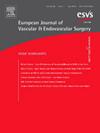Editor's Choice – Delays to Revascularisation and Outcomes of Non-Elective Admissions for Chronic Limb Threatening Ischaemia: a UK Population Based Cohort Study
IF 5.7
1区 医学
Q1 PERIPHERAL VASCULAR DISEASE
European Journal of Vascular and Endovascular Surgery
Pub Date : 2025-04-01
DOI:10.1016/j.ejvs.2024.12.038
引用次数: 0
Abstract
Objective
Major amputation and death are significant outcomes after lower limb revascularisation for chronic limb threatening ischaemia (CLTI), but there is limited evidence on their association with the timing of revascularisation. The aim of this study was to examine the relationship between time from non-elective admission to revascularisation and one year outcomes for patients with CLTI.
Methods
This was an observational, population based cohort study of patients aged ≥ 50 years with CLTI admitted non-electively for infrainguinal revascularisation procedures in English National Health Service hospitals from January 2017 to December 2019 recorded in the Hospital Episode Statistics database. Outcomes were death and ipsilateral major amputation rate at one year. Logistic regression models were fitted to explore the relationship between time to revascularisation and death, adjusted for patient and admission factors. For major amputation, multinomial logistic regression models were used to account for the competing risk of death.
Results
A total of 10 183 patients (median age 75 years) were included in the analysis, of which 67.1% (n = 6 831) were male and 57.6% had diabetes. In patients with tissue loss, the unadjusted one year mortality rate was 30.0% (95% confidence interval [CI] 28.9 – 31.0%), and for every one day increase in time from admission to revascularisation, the adjusted odds of one year death increased by 3% (odds ratio 1.03, 95% CI 1.02 – 1.04). In the absence of tissue loss, the unadjusted one year mortality rate was 19.9% (95% CI 18.4 – 21.4%) and there was no evidence of an association with time to revascularisation. There was also no statistically significant association between the time to revascularisation and risk of ipsilateral major amputation at one year irrespective of tissue loss.
Conclusion
Patients undergoing infrainguinal revascularisation during non-elective admissions for CLTI have high one year major amputation and mortality rates. Longer time from admission to revascularisation was independently associated with a higher mortality rate in patients with tissue loss, but not in those without.
慢性肢体威胁性缺血延迟血运重建和非选择性入院的结果:一项基于英国人群的队列研究。
目的:严重截肢和死亡是慢性肢体威胁性缺血(CLTI)患者下肢血运重建术后的重要结局,但其与血运重建术时间的相关性证据有限。本研究的目的是研究从非选择性入院到血管重建的时间与CLTI患者一年预后之间的关系。方法:这是一项观察性、基于人群的队列研究,研究对象为2017年1月至2019年12月在英国NHS医院非选择性接受腹股沟下血管重建术的年龄≥50岁的CLTI患者,记录在医院事件统计数据库中。结果为一年内的死亡率和同侧大截肢率。拟合逻辑回归模型,探讨血运重建时间与死亡之间的关系,并根据患者和入院因素进行调整。对于主要截肢,使用多项逻辑回归模型来解释竞争死亡风险。结果:共纳入10 183例患者,中位年龄75岁,其中67.1% (n = 6 831)为男性,57.6%为糖尿病患者。在组织丢失患者中,未经调整的一年死亡率为30.0%(95%可信区间[CI] 28.9 - 31.0%),从入院到血运重建每增加一天,调整后的一年死亡率增加3%(优势比1.03,95% CI 1.02 - 1.04)。在没有组织损失的情况下,未经调整的一年死亡率为19.9% (95% CI 18.4 - 21.4%),没有证据表明与血运重建时间有关。血管重建的时间与一年后同侧大截肢的风险之间也没有显著的关联,无论组织损失如何。结论:在CLTI非择期住院期间接受腹股沟下血管重建术的患者有很高的一年主要截肢率和死亡率。从入院到血运重建的时间较长与组织丢失患者的高死亡率独立相关,但与无组织丢失患者无关。
本文章由计算机程序翻译,如有差异,请以英文原文为准。
求助全文
约1分钟内获得全文
求助全文
来源期刊
CiteScore
6.80
自引率
15.80%
发文量
471
审稿时长
66 days
期刊介绍:
The European Journal of Vascular and Endovascular Surgery is aimed primarily at vascular surgeons dealing with patients with arterial, venous and lymphatic diseases. Contributions are included on the diagnosis, investigation and management of these vascular disorders. Papers that consider the technical aspects of vascular surgery are encouraged, and the journal includes invited state-of-the-art articles.
Reflecting the increasing importance of endovascular techniques in the management of vascular diseases and the value of closer collaboration between the vascular surgeon and the vascular radiologist, the journal has now extended its scope to encompass the growing number of contributions from this exciting field. Articles describing endovascular method and their critical evaluation are included, as well as reports on the emerging technology associated with this field.

 求助内容:
求助内容: 应助结果提醒方式:
应助结果提醒方式:


